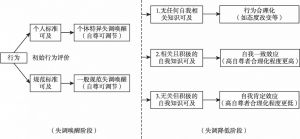章节
认知失调论60年
摘要
认知失调论自20世纪50年代问世以来,激发了大量的经验研究、理论创新和观点争辩,形成一个“树大根深”的体系。其发展经历了以下几个重要阶段:经典认知失调论及四种经典实验范式的提出;经历学术论辩与修正后整合为新视角模型;“自我”的洞见催生出新的研究范式和领域;统一的自我标准模型的构建;群体层面的认知失调以及跨文化研究、认知神经机制等当代新进展。本研究以纵向的理论发展史为脉络,厘清了其起承转合的内部逻辑,并标记出其中的重要节点和由此开辟的研究领域,以期增进国内学术界对该领域的理解,推动相关研究的展开。
作者
检索正文关键字
章节目录
-
一 经典认知失调论的石破天惊
- (一)费斯汀格的《认知失调论》
- (二)早期的经典研究及范式
- 1.自由选择范式(the Free-Choice Paradigm)
- 2.信念失验范式(the Belief-Disconfirmation Paradigm)
- 3.心血合理化范式(the Effort Justification Paradigm)
- 4.诱导依从范式(the Induced Compliance Paradigm)
-
二 论辩与修正:刺激效应还是动机效应?
- (一)奖赏-刺激论的挑战和修正因子的探求
- (二)自我感知论的挑战和动机性质的澄清
-
三 整合的新视角模型:“不一致”还是“后果”?
- (一)“后果”
- 1.后果的厌恶性
- 2.后果的可预见性
- (二)新视角模型
- (三)争议:厌恶性后果是否必需?
- (一)“后果”
-
四 失调中的“自我”之争
- (一)自我一致观
- (二)伪善范式
- (三)自我肯定论
- (四)降低失调的途径:直接与间接
- (五)有关自尊的分歧
- (六)自我标准模型
-
五 群体认同视域下的认知失调
- (一)替代性失调
- (二)社会支持与元一致性
-
六 当代认知失调领域的其他进展
- (一)跨文化研究
- (二)理论的进一步修正
- (三)失调的神经机制
- (四)联结主义模型
- 七 结语
相关文献
查看更多>>>



